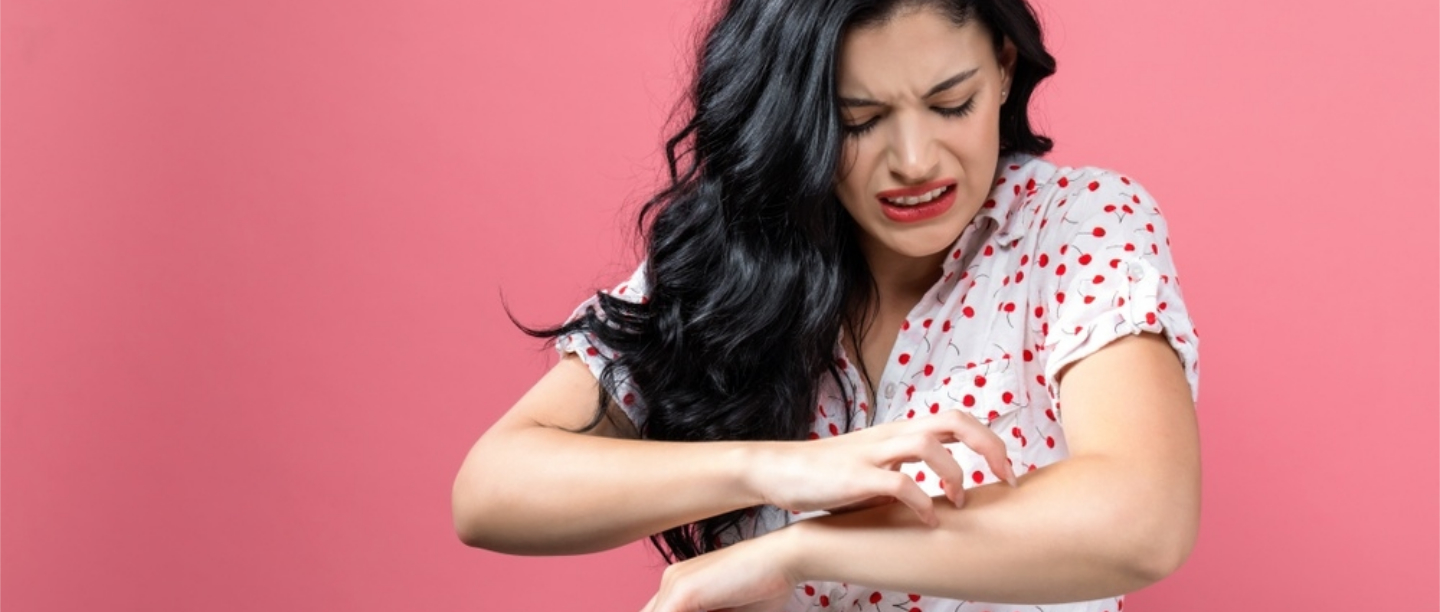
My first experience with eczema was when I was 14 years old. Tiny red dots would appear randomly all over my body during the monsoon. They would itchy like crazy and if I continued to scratch, my skin would flare up, become sore and red. The itchiness would fade away only after an hour and the red dots would disappear as well leaving behind tiny scars. I visited three dermatologists and unfortunately, none of them managed to permanently cure my skin.
According to my research, there is no cure for eczema. There may be periods where it disappears for years and suddenly reappears. For me, personally, it seems to peak during the monsoons. Humidity triggers eczema by making the skin dry and itchy. If you’re suffering from seasonal eczema too, I would recommend that you moisturise at least twice a day. If the itchiness gets uncontrollable, don’t scratch (it will only aggravate the skin) apply an anti-itch cream prescribed by your dermatologist. Forget about hot and cold showers for a while, you’ll have to bathe in lukewarm water. Just like eczema, the monsoons also bring a host of new skin allergies. Let’s find out what they are!
5 Types Of Skin Allergies & How To Treat Them
In India, the hottest months are from May to June and the temperature drops dramatically by the end of June and the beginning of July. While it is cool and pleasant during the monsoons, understand that skin concerns multiply during this time. Other than eczema, you’re about to find out which ones…
1. Facial Folliculitis
Sounds complicated, but they are essentially inflamed hair follicles. They appear as tiny red bumps on your forehead. Bacterial and fungal infections are to be blamed. Fungal infections are severe during the monsoons and trigger facial folliculitis if you sweat, are dehydrated and exposed to humidity. Best way to combat facial folliculitis is to keep your hair and skin clean and dry. If you sweat a lot after your workouts, wash your face, hair and scalp immediately. Drink plenty of water, exfoliate and moisturise often and make sure you keep your skin clean and dry.
2. Hyperhidrosis
It’s common to sweat in areas like the palms, armpits, face and torso during the monsoons. However, hyperhidrosis causes excess sweating and foul body odour and that attracts infection-causing bacteria. Getting drenched in the rain and wearing damp, sweaty clothes for long hours during the monsoons is a big no-no! You see, humidity encourages bacteria and fungi growth on the skin which triggers skin diseases such as hyperhidrosis. The natural way to treat this type of skin allergy is to hydrate well and moisturise your skin after a shower when it’s damp. If it gets worse, you can always opt for deodorants that block sweat, or as a last resort for extreme cases of sweating – botox. Yes, botox isn’t only meant to reduce the appearance of wrinkles and fine lines, it can be used to treat hyperhidrosis too. Each Botox injection contains botulinum toxin that helps to block the nerve signals which are responsible for sweating. Thus, making you sweat less.
3. Hyperpigmentation
Dark, dull patches on the skin are a result of hyperpigmentation. You see, direct exposure to the sun activates melanocytes and they become hyperactive. And while you may not see the sunrays in the monsoons, thanks to the cloudy weather, UV rays can still damage your skin. Try to limit your skin’s exposure to the sun. Remember, the sun is the strongest from 10 am – 4 pm. If you have to step out, wear sunscreen and protective clothing. For treating hyperpigmentation, you may have to undergo laser treatment or opt for microdermabrasion. For medication and topical treatment, it’s best to loop in your dermatologist.
4. Skin Allergies
This type of skin allergy has no name and is caused by multiple factors. Living in polluted cities and an unhygienic environment can trigger allergies. Some common triggers are dust mites, pollen, fur from pets and ragweed. These type of skin allergies worsen during the monsoons due to excess humidity in the air. When your body comes in contact with these irritants, it produces a chemical called histamine. These general allergies can show up in the form of hives, rashes, redness, itchy patches or even a cold and cough. To get relief from these, you might have to take an anti-allergen. Essentially, a pharmaceutical drug that contacts antihistamines. These help to block histamine and prevent it from creating a ruckus on your skin’s surface. Consult with your dermatologist before buying any drug over the counter. You can also use calamine lotion topically to minimise itching and soothe irritated skin.
5. Scabies
While this isn’t an allergy, this contagious skin disease can occur in humid weather, especially during the monsoons. Microscopic mites dig into your skin, lay eggs and cause severe itching. They spread through physical contact and contaminated water. The mites are so tiny that can barely see them with the naked eye. To treat this skin disease, one must invest in a topical lotion prescribed by the doctor. Bedsheets should be washed often with hot water and one must keep a safe distance from the affected to prevent the mite from hopping from skin to skin. While this is not common, it could potentially happen & it is recommended that you seek help from a doctor immediately.
To minimise your risk of getting a skin allergy during the monsoon, maintain good hygiene, keep your skin dry and hydrated.
Images: Shutterstock